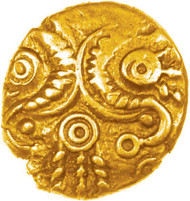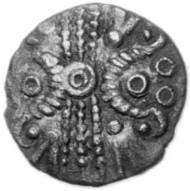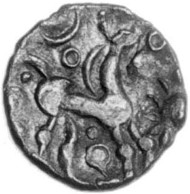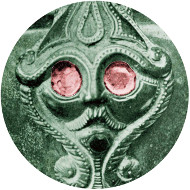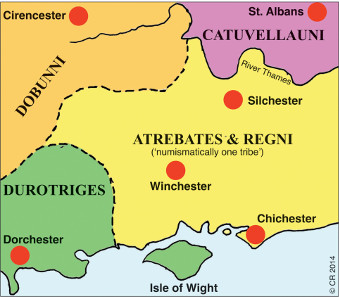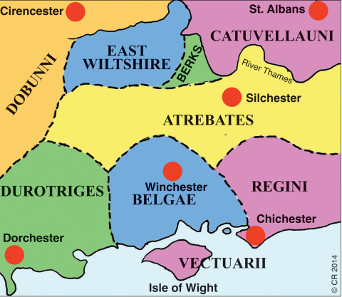by Chris Rudd
August 21, 2014 – On 7 March 2014 a small but exceedingly rare gold coin was found by a metal detectorist near Winchester, Hampshire. Minted c.50-30 BC and weighing no more than a gram, this Ancient British gold quarter stater shows two snakelike corded crescents on one side – arranged to form a fierce hidden face – and a lanky belted horse on the other side. Only one other example is recorded.
1. Corded Crescents gold quarter stater, 10mm, 0.97g, c.50-30 BC. Found near Winchester, 7.3.2014, and previously unpublished.
The importance of this Iron Age coin, apart from its great rarity, is its provenance. Winchester – Venta Belgarum (‘market place of the Belgae’) – was the Roman, and possibly pre Roman, capital of the British Belgae tribe. Until recently the Belgae of Hampshire were numismatically ‘dead’. Nobody attributed any Iron Age coins to them. R P Mack (1953) didn’t, R D Van Arsdell (1989) didn’t, R Hobbs (1996) didn’t.
2. Moon Horns silver half unit, 11mm, 0.42g, c.50-30 BC, ABC 956. Found near Chichester, 13.10.1998, and attributed to the Belgae.
Most uninscribed coins found in Hampshire were automatically given to the Atrebates, whose capital was Calleva (‘place in the woods’), now known as Silchester. Other Hampshire coins, such as Chute and Cheriton gold staters (ABC 746-755), were given to the Durotriges, whose heartland was in Dorset.
3. For 500 years surrealistic hidden faces were a common feature of Iron Age art. The coin’s bearded head is not dissimilar in style to one on a bronze flagon, c.450 BC, from Basse-Yutz, NE France. Picture (flagon detail) by Paul Jacobsthal, Early Celtic Art, OUP 1969, pl.381b, © The British Museum.
However, in 1994 I noted that there seemed to be people between the Atrebates and Durotriges who issued their own coins in the 1st century BC. In 1997 I suggested that these people were the long-forgotten Belgae, mentioned by Sir John Evans in 1864 as possible coin-issuers, but ignored by numismatists for the next 130 years.
4. Van Arsdell (1989) said the Atrebates and Regni were “numismatically one tribe” and “only one coinage circulated in the tribal territory”. Still a common misconception among older archaeologists.
Evidence that the Belgae of Hampshire made their own money continues to mount. “Ancient British Coins” (Chris Rudd 2010) attributes no fewer than 84 different coin types – 30 gold, 54 silver – to the Belgae.
5. Coins found by metdets since the early 1990s suggest that six tribal groups issued coins south of the Thames, including the Belgae of Hampshire who almost died of numismatic neglect.
One of them, a silver half unit (ABC 956), has an almost identical design to the newly discovered gold quarter stater from near Winchester. So I feel sure that both were minted by the same Belgae ruler. These two little coins add a little more life to a tribe that almost died. Once again I thank the metal detectorists who continue to report their Ancient British coin finds.
All pictures (coins) by courtesy of Elizabeth Cottam and Chris Rudd.
The Corded Crescents gold quarter stater will be sold by auction at Aylsham, Norfolk, 8 September 2014, by Elizabeth Cottam of Chris Rudd. For further information email Elizabeth Cottam.
For more information on Chris Rudd and his auctions, please visit his website.
If you are interested in Celtic coins and history, don’t miss our archive!




